 Hartlepool Sports & Leisure
Hartlepool Sports & Leisure
- Cinemas, Theatres & Dance Halls
- Musicians & Bands
- At the Seaside
- Parks & Gardens
- Caravans & Camping
- Sport
 Hartlepool Transport
Hartlepool Transport
- Airfields & Aircraft
- Railways
- Buses & Commercial Vehicles
- Cars & Motorbikes
- The Ferry
- Horse drawn vehicles
 A Potted History Of Hartlepool
A Potted History Of Hartlepool
- Unidentified images
- Sources of information
- Archaeology & Ancient History
- Local Government
- Printed Notices & Papers
- Aerial Photographs
- Events, Visitors & VIPs
 Hartlepool Trade & Industry
Hartlepool Trade & Industry
- Trade Fairs
- Local businesses
- Iron & Steel
- Shops & Shopping
- Fishing industry
- Farming & Rural Landscape
- Pubs, Clubs & Hotels
 Hartlepool Health & Education
Hartlepool Health & Education
- Schools & Colleges
- Hospitals & Workhouses
- Public Health & Utilities
- Ambulance Service
- Police Services
- Fire Services
 Hartlepool People
Hartlepool People
 Hartlepool Places
Hartlepool Places
 Hartlepool at War
Hartlepool at War
 Hartlepool Ships & Shipping
Hartlepool Ships & Shipping

St Aidan's Memorial School
Details about St Aidan's Memorial School
This school opened in 1926. See also notes and images for St Aidan's Longhill.
Location
Related items :
 West Hartlepool Station St Aidan's Senior Girls
West Hartlepool Station St Aidan's Senior Girls
 Donated by St Aidan's Primary School
Donated by St Aidan's Primary SchoolThese St Aidan's senior girls appear to be on the northbound platform, perhaps off to Newcastle or Edinburgh? The fashions suggest that the photograph was taken just after WW2 perhaps ?
More detail » Child Welfare Course 1966
Child Welfare Course 1966
 Created by Hartlepool Mail
Donated by St Aidan's Primary School
Created by Hartlepool Mail
Donated by St Aidan's Primary SchoolDated 1966
This image shows teacher Mrs Price with senior girl pupils doing a childcare course. This would probably be the last year of the senior girls, as around this time the senior department of the school closed.
The back of the photo reveals that they were all successful on the course.
More detail » Girls in Domestic Science 1949
Girls in Domestic Science 1949
 Donated by St Aidan's Primary School
Donated by St Aidan's Primary SchoolDated 1949
Senior girls in the domestic science room, a large room which later became the first nursery at the Stockton Road end of the school. As well as the obvious cookery which is taking place here, the girls must have been taught how to wash clothes indicated by the mangle on the end of the table in the front.
The image is from 1949.
More detail » Longhill 1959
Longhill 1959
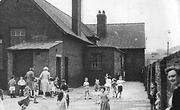 Donated by Frances Wilson
Donated by Frances WilsonDated 1959
Taken around 1959, the picture shows the playground of St Aidan's Infant School Longhill. On the right wearing glasses is the headmistress Miss Molly Pattison who later went on to Oxford Street School.The other two adults are Reta Campbell and Jean Bluckert. Behind the wall on the right was Windermere Road and behind the school were the Steelworks cooling towers. Just out of sight is Seaton High Light which has now been moved to the Marina.
The infants' school moved to St Aidan's Loyalty Road in 1960-1.
More detail » Longhill School
Longhill School
My mother taught at St Aidan's Infants School Longhill and was called Mrs Johnson. As a young child I visited the school many times and it sticks in my memory more vividly than Lister Street Infants' which I attended myself. The reasons must be because even to my 7or 8 year old brain, I must have realised that I was stepping back in history and that this school was nothing like the one I attended.
Firstly, the journey to get there. Before we had a car, we walked what seemed like miles until the streets became orange with what I now realise was iron dust and mud. The school was a small building shadowed by a huge steel works cooling tower and there were clanking noises all around. On a small piece of scrubland next to the school were a scattering of gypsy caravans and horses.
Until the school closed in 1960,there were huge open fires for heat and the lighting was still by gas. I do remember being frightened of the toilets at the bottom of the yard which were holes in planks of wood and if I remember rightly they had no flush but periodically were ' flushed ' by a mystery flow of water. I do remember that the school quite often had a break in and helping to tidy up piles of chalk, books and drinking straws! The schoolroom at Beamish reminds me of what I remember of Longhill 'little school' .
More detail » Longhill School History
Longhill School History
In 1998, the 'All our Yesterdays' Writers' Group published a book Reflections Beneath the Wagga Moon and the following are from that book which is in Hartlepool Library.
Thomas Richardson, a Liberal rival of Ralph Ward Jackson, wanted votes at the 1874 elections and this is one of the reasons he purchased the blast furnaces and rolling mills to the south of Stranton. He then built homes for his workers in the area of Seaton parish known as Longhill. Because the area was undrained, unpaved, unlit and was also a site for travelling families, it became known as Wagga. The more affluent workers settled in the South Parade and Studley Road areas of nearby Belle Vue.
The three main streets built at the time by Richardson were Florence Street, Hill Street and Portland Street. Slightly to the north west of these streets and separated by bogs and random allotments were Sarah Street, Alice Street and King Street.
A school,known as 'Wagga College' by the residents of the area, was built, but it was some years later in the early 1900s ,that it was linked by a cinder track to Windermere Road and on to Brenda Road.
The school was built in 1874 when Richardson gave some land to the Archdeacon of Durham and the Vicars of Seaton and Greatham on which to build a school and he himself donated £200 of the £900 it cost to build.
In 1913, WR Owen in his book about education in Hartlepool observed 'The district was known as Wagga Wagga on account of its wild aspect. The approaches were bogs and altogether it was not the most desirable of residence.' In 1875, there were four headteachers in a year which has been attributed to the unpleasant surroundings of the school.
In 1890, because of the formation of St Aidan's Parish, the school was no longer in Seaton Carew parish and was renamed St Aidan's Church of England School Longhill. R.E. Knowlden who was priest from 1897, showed concern for the school. The area around it was little better than when it was built although some pathways had been laid. In 1899 an Infants' School was begun and in 1902, opened. Prior to this, children of all ages had been in the 1874 building.
Inspectors in 1909 said 'The school is overcrowded, one room contains 84 children. There are only 3 closets for 200 boys. The walls are very dirty. Guards should be provided for the open fireplaces.
Rev Knowlden continued to show concern for the state of the school, and when some 102 past pupils did not return from WW1, he decided that a fitting memorial to them would be a new school. He spent much of the next 10 years fundraising and on the 21st May 1926 the school was ready for pupils.
In May 1926, 336 scholars were marched from Longhill to the new Memorial School in Loyalty Road leaving just the youngest children at Longhill. Rev Knowlden and staff and children continued to fund raise although he himself passed away in November 1929.
Susan Moore was for many years a teacher, having been employed initially by Rev Knowlden. She then became headteacher at Longhill Infants and later at Loyalty Road when the children finally moved there in 1960 and these are some of her words:
'I became headteacher of St Aidan's Infants' School in 1947 and I look back with great pleasure at those years spent in the old building which lacked all the modern facilities of schools today. It came as a shock to me to discover that the old fashiioned lavatories where one tank flushed the channel of a whole row of toilets, were still in use.
The staff spared no effort in making the school attractive and teaching effective. and when showing of films became fashionable, Miss Molly Pattison made a projector which had to be run from a car battery as we had no electricity, only gas in school.
Despite the proximity of the heavy industrial works, the health and consequently attendance of the children was very good.. We were always the last to suffer from epidemics of measles, chicken pox and mumps.
During my retirement, I meet many old pupils and they all look back, as indeed staff do, with pleasure and gratitude to the days when they lived and learned in a controlled but happy atmosphere.' (Miss Moore lived to be over 100 having been born in 1906)
By 1940, the original streets of Wagga, Florence, Hill and Portland were empty and were used by the Auxiliary Fire Service for war time survival practice. Infant age children attending the school came from the Belle Vue area. After World War 2, quite a significant number of 'prefab' bungalows and houses were built close to the school in Coniston Road, Langdale Grove, Shap Grove and Bowness Grove. These houses too are long gone and, like Longhill School, would have been to the east of Belle Vue Way in an area of recycling plants and scrap yards today.
In 1960, the school closed and children were tranferred to the Memorial School in Loyalty Road on December 10th of that year.
In 1964, the old Longhill School was sold to scrap merchant J Shaw for £1,119 15s 9d for use a store room. Now, Longhill has gone completely and there is no evidence at all of where either houses in 'Wagga' or the school stood.
More detail » Longhill class 1956
Longhill class 1956
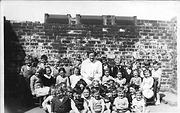 Donated by St Aidan's Primary School
Donated by St Aidan's Primary SchoolDated 1956
The teacher is Mrs Reta Campbell who, when the infants moved to Loyalty Road, became deputy headteacher.
More detail » St Aidan's Boys School - Standard 1, 1949
St Aidan's Boys School - Standard 1, 1949
 Donated by Mr. Jimmy Buglass
Donated by Mr. Jimmy BuglassDated 1949
St Aidan's Boys School, Standard 1, 1949.
Jimmy Buglass is seated on the front row, third from the right. Do you recognise anyone elso in the photograph?
More detail » St Aidan's Girls' staff 1949
St Aidan's Girls' staff 1949
 Donated by St Aidan's Primary School
Donated by St Aidan's Primary SchoolDated 1949
On the top row second from left is Miss Effie Fawcett, then ? , then Miss Evelyn Burnham. On the front row on the far right Mrs Trixie Flewker.
All these named teachers remained at the school for many years until the late 1960s.
More detail » St Aidan's Infants, Longhill 1952
St Aidan's Infants, Longhill 1952
 Donated by Christine Fox
Donated by Christine FoxDated 1952
St Aidan's Infants, Longhill 1952.
Known faces are : 7th from left back row Alfie Walsh.
Middle: ?, ?,Harold Hatley, Veronica Bennett, Paula Nash, Linda Braham, Ivor THomas, ?, Carole O Connor, ?, ? , Tommy Rudd, ?
Front row: 4th from left Marlene Hall,?,Margaret Pike, Irene Chilton, ? ,?, Miss Dobson, ?, Carole Thompson, Pauline Ainsley, ? , Valerie STott , Jaqueline Playfor
The teacher is Miss Doreen Rouse, who later married Seaton Golf Professional Roy Harlow.
More detail » St Aidan's Memorial School
St Aidan's Memorial School
This school opened in 1926. See also notes and images for St Aidan's Longhill.
More detail » St Aidan's Memorial School
St Aidan's Memorial School
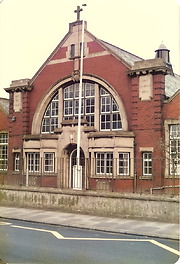 Created by Bill Henderson
Donated by Bill Henderson
Created by Bill Henderson
Donated by Bill HendersonTaken in the mid 1980s
More detail » St Aidan's Nursery 1975
St Aidan's Nursery 1975
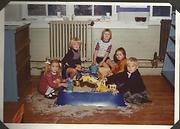 Donated by Nanette Hanson
Donated by Nanette HansonDated 1975
The Nursery at this point was new and made use of the large domestic science classrooms vacated when the senior girls' department of St Aidan's was closed.
On the bottom right is Mark Hanson
More detail » St Aidan's Y6 1978
St Aidan's Y6 1978
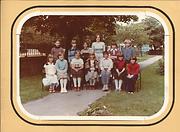 Donated by Nanette Hanson
Donated by Nanette HansonDated 1978
Group of Y6 children at front of St Aidan's School Loyalty Road. In the background is the Greenside Hotel before it was demolished and rebuilt.
More detail » St Aidan's staff 1965
St Aidan's staff 1965
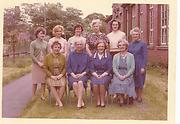 Donated by Frances Wilson
Donated by Frances WilsonDated 1965
Staff of Infants' and Secondary Girls' departments 1965. In the background is the house which would soon become the original Greensides public house.
More detail » Swimming team 1961
Swimming team 1961
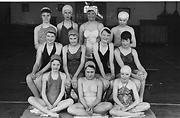 Donated by St Aidan's Primary School
Donated by St Aidan's Primary SchoolDated 1961
Members of St Aidan's School swimming team
More detail » Winners 1976
Winners 1976
 Donated by Nanette Hanson
Donated by Nanette HansonDated 1976
Inter School British Architects Competition Winners St Aidan's. Top left is John Hanson
More detail »




